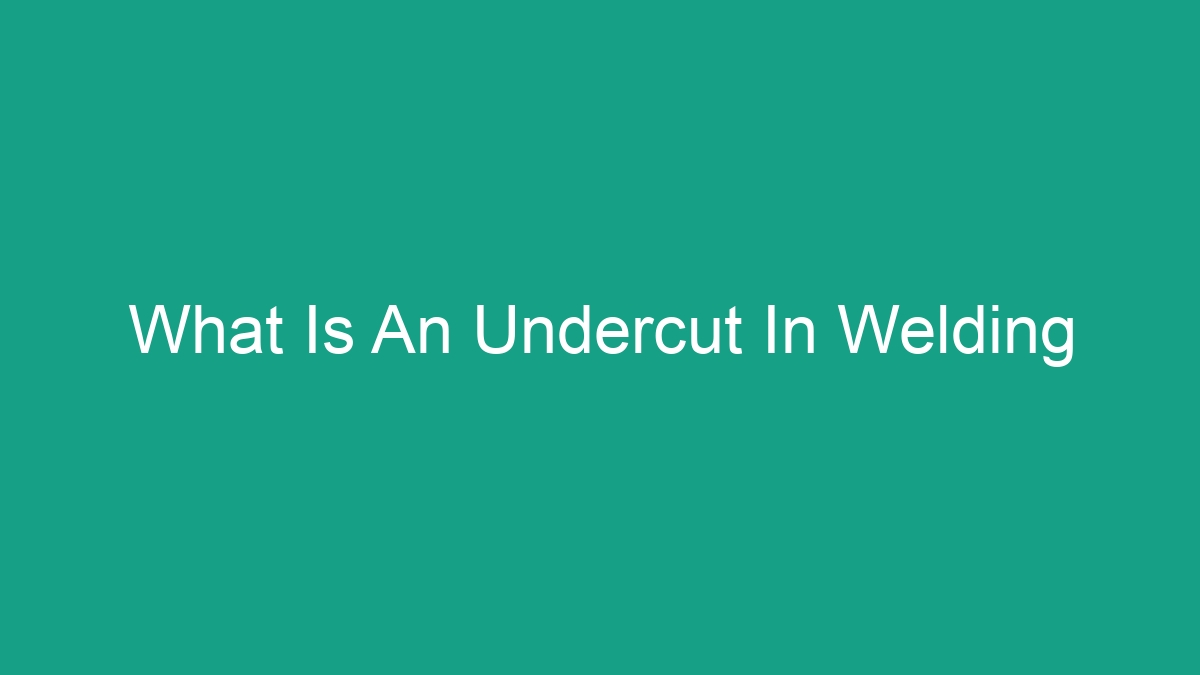
When it comes to welding, there are various terms and techniques that are important to understand in order to ensure the quality and strength of the weld. One such term is “undercut,” which is a common welding defect that can affect the integrity of the weld. In this article, we will explore what an undercut is in welding, what causes it, and how to prevent it.
Understanding Undercut in Welding
Undercut in welding refers to a groove or depression that is formed in the base metal or parent metal next to the weld toe and along the weld face. This defect can compromise the strength and integrity of the weld, making it susceptible to cracking and failure.
Undercut is typically characterized by a groove or indentation along the edges of the weld, and it is often accompanied by insufficient filler metal deposition in the affected area. This creates a weak point in the weld, which can lead to structural weakness and failure under stress.
Causes of Undercut
There are several factors that can contribute to the formation of undercut in welding. It is important to understand these causes in order to prevent this defect from occurring.
- Excessive heat: One of the main causes of undercut is excessive heat input during the welding process. When the heat is too high, it can lead to excessive melting of the base metal, creating a groove along the edges of the weld.
- Improper welding technique: Incorrect welding technique, such as excessive weaving or high travel speed, can also result in undercut. Inadequate control of the welding process can lead to poor penetration and insufficient filler metal deposition, causing a depression in the base metal.
- Incorrect electrode angle: The angle at which the welding electrode is held during the welding process can also contribute to undercut. If the electrode angle is too steep, it can create a groove in the base metal, leading to undercut.
- Base metal contaminants: Presence of contaminants such as oil, grease, or rust on the base metal can also contribute to the formation of undercut. These contaminants can affect the flow of the molten weld metal and create a depression in the base metal.
Preventing Undercut
Preventing undercut in welding involves implementing proper welding techniques and controls to ensure the quality and integrity of the weld. Here are some steps that can be taken to prevent undercut:
- Optimize welding parameters: Proper control of welding parameters such as heat input, travel speed, and weaving pattern is crucial in preventing undercut. By optimizing these parameters, the risk of excessive heat and poor penetration can be minimized.
- Use the correct electrode angle: Maintaining the proper angle of the welding electrode is essential in preventing undercut. It is important to ensure that the electrode is held at the correct angle to promote proper metal deposition and penetration.
- Prepare the base metal: Thoroughly cleaning the base metal to remove any contaminants such as oil, grease, or rust is essential in preventing undercut. Proper preparation of the base metal ensures good flow of the molten weld metal and minimizes the risk of groove formation.
- Inspect the weld: Regular inspection of the weld during and after the welding process is important in identifying any signs of undercut. By detecting potential undercut early, corrective action can be taken to prevent further progression of the defect.
Repairing Undercut
In some cases, undercut may be identified after the welding process is complete. When this occurs, it is important to take the necessary steps to repair the undercut and restore the integrity of the weld. The following methods can be used to repair undercut:
| Method | Description |
|---|---|
| Grinding | Using a grinding tool to remove the undercut and smoothen the affected area. |
| Filler metal deposition | Applying additional filler metal to fill the groove and build up the affected area. |
| Weld overlay | Applying a new layer of weld metal over the undercut area to build up the affected region. |
It is important to note that the method of repairing undercut may vary depending on the severity of the defect and the specific welding process used. It is recommended to consult with a welding expert to determine the most appropriate repair method for the specific situation.
Conclusion
Undercut in welding is a common defect that can compromise the strength and integrity of the weld. Understanding the causes of undercut and implementing proper preventative measures is essential in ensuring the quality of the weld. By optimizing welding parameters, maintaining the correct electrode angle, and thorough base metal preparation, the risk of undercut can be minimized. Additionally, regular inspection of the weld and prompt repair of any undercut that is identified is crucial in preventing further progression of the defect.
Overall, by having a comprehensive understanding of undercut and taking the necessary steps to prevent and repair it, welders can ensure the quality and durability of their welds, leading to safe and reliable welded structures.


